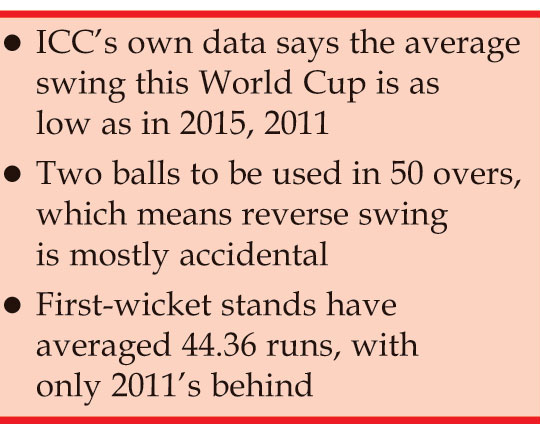Since the World Cup is being played in the typical overcast English conditions, some experts predicted that swing bowling will make an impact at the end of the day. With early morning starts in overcast conditions and slip fielders waiting to pounce on every outside edge off the bat, many anticipated the tournament to be a seam bowlers' paradise.
 But the new white ball has not swung as much as expected in the conditions at the Cricket World Cup 2019. The International Cricket Council (ICC)'s own data says the average swing this World Cup is as low as in the 2011 one.
But the new white ball has not swung as much as expected in the conditions at the Cricket World Cup 2019. The International Cricket Council (ICC)'s own data says the average swing this World Cup is as low as in the 2011 one.
Two thirds of the way through the World Cup league stage the average swing generated by bowlers sits at 0.649 degrees, compared with 0.993 in Australia and New Zealand in 2015, according to (ICC) statistics.
The figures show the difference between the actual delivery and the trajectory of the ball if it does not undergo any swing.
The lack of ball movement is comparable to the 2011 World Cup, which produced an average of 0.637 degrees, held in the sub-continent where the tracks tend to be either dry or slow.
Swing went out of the ODI game just after the last World Cup. There are two balls to be used over 50 overs, which means reverse swing is mostly accidental. Spin, despite the brief surge on account of Southampton, is averaging 47 per wicket.
The opening partnerships at this World Cup have been more prolific than at almost any time in the tournament's history.
First-wicket stands have negotiated the new ball with confidence and have averaged 44.36, with only 2011, when they averaged 45.20, seeing openers make more runs.
They yielded 31.18 on average in 2015, 29.23 in 2007 and 35 in 2003.
Australia and India have been the shining examples of building on aggressive starts at the top of the order.
Captain Aaron Finch and David Warner have combined for 447 runs in six innings, building on Australia's average of 53.81 for the first wicket in one-dayers since 2015, the highest in the world.
India have lost Shikhar Dhawan to injury but his replacement Lokesh Rahul alongside in-form Rohit Sharma have shown they can continue to build their innings from the top - having recorded 18 100-run stands for the first wicket since 2015.
West Indies, who have one win in six matches, have failed to find solutions with the bat at the top of the order and remain the only team not to muster a first-wicket half-century stand.
Openers have been particularly severe on length bowling, traditionally the most profitable option up front, giving the new ball the best chance to swing.
Balls on a length from seamers in the first 10 overs have caused problems in the past in World Cups, but batsmen have a batting average against it twice that of four years ago. In 2019, batsmen average 44.04 runs and length bowling has taken 23 wickets compared to an average of 22.58 and 79 wickets back in 2015.